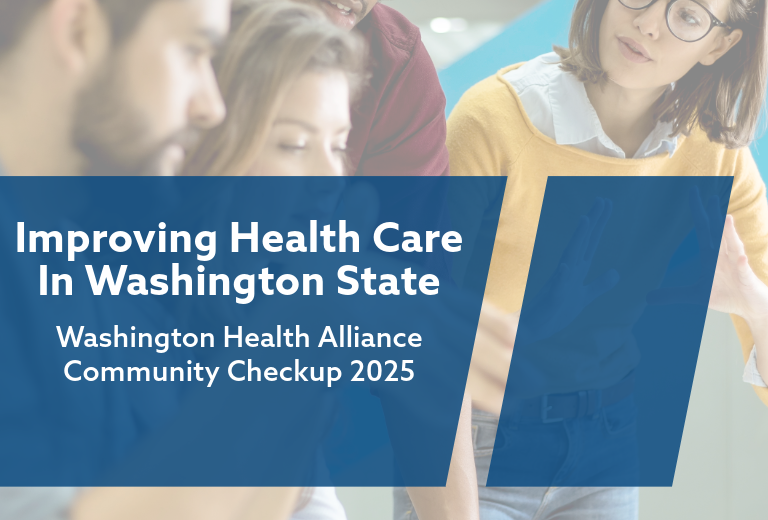WHA releases 2025 Community Checkup with focus on health care value
View the Community Checkup Highlights and More
To our members and the community:
The Washington Health Alliance was founded, first as the Puget Sound Health Alliance, 20 years ago with a mission to improve the quality of care our families, friends and neighbors receive from the health care system.
This 19th edition of the Community Checkup, which started as a first-in-the-nation report on the quality of care at the local level, has been built on 20 years of expertise among our membership, board leadership and staff.
For these two decades, measuring quality has spurred efforts to improve care. However, progress has stagnated as organizations are facing tremendous market pressures, financial shortfalls, consolidations and reorganization, and shifts in the fundamental ways people interact with health care. Despite the historically low rate of uninsured people, access to timely, coordinated, comprehensive and continuous care remains elusive.
No one foresaw how a global pandemic would result in dynamic changes in how the health system operated, the rapid consolidation of health systems or how shifting federal, state and local priorities could bring about complexities that require their own innovative solutions.
We know our performance on many essential measures, from key cancer screenings to timely well-care visits, has been waning for years. Statewide, we have not risen against the National 90th percentile on any measure, the WHA quality benchmark, in some time, and we continue to lose ground as thousands and thousands of Washingtonians are left untreated.
We must act and make clear data-driven choices. We must recognize quality of care for what it truly is: a key component in the value of care our friends and neighbors receive.
At the outset, WHA exercised caution, as a multistakeholder coalition, electing to focus our conversation solely on quality. We focused on defects and waste – overuse, misuse and underuse of care. Nevertheless, three years ago we began transparent, thorough reporting on both quality and cost of care. The definition of value.
More than ever, those who purchase health care must demand outcome-based results. Health care expenses are now the second largest expense for companies behind salaries and above materials, supplies and other operating costs. Purchasers must embrace the opportunity to treat health care as any other part of their business and demand value for their investment. This means making choices that drive quality, flatten costs and result in better, more equitable health outcomes including productivity.
Purchasers should expect a return on these investments, as better health outcomes, lower expensive utilization, improved productivity (i.e. absenteeism, presenteeism and reduced error rates) impact overall business performance, and flattened cost trends allow for investments elsewhere in their organizations. Some choices may disrupt current vendor relationships, may drive members to have a primary care provider and enable navigation to the highest quality specialty care. Our next 20 years’ success story will be about how we worked together to improve the systems of care, strengthened purchaser/business operations and maintain a sustainable health system delivering appropriate care in the settings with the best results.
As an independent organization, we are fortunate that our membership community continues to support WHA. We are therefore able to offer in-depth, transparent views of quality, access, equity and cost, leveraging the power of our All-Pay Claim Database.
There are clear dimensions to ensure we are providing high-value care:
- Is the care appropriate?
- Are the outcomes of that care in the top 25% nationally?
- Are the costs of delivering the care better than the market average?
- Do Washingtonians have full access to the services they need through removing socioeconomic and equity drivers and direct care coordination?
To improve the administrative burden on health plans and providers, WHA could be the single source for aggregated quality and cost reporting for provider organizations across participating member health plans.
We know these aspects can be viewed through several measures and can play a sizable role in the health care marketplace from the crucial decisions employers and union trusts make to meet their fiduciary responsibilities to the efforts taken at the clinic level to engage with disparate communities.
In this report, we will highlight the ways in which the Community Checkup can start to sharpen our view on the value of care. Together, our membership, our leadership, our staff and our community can craft a road map that balances these important metrics to ensure high-value care is the only care Washingtonians receive.
Sincerely,
Andrew B. Oliveira, MD, MHA
Executive Director

